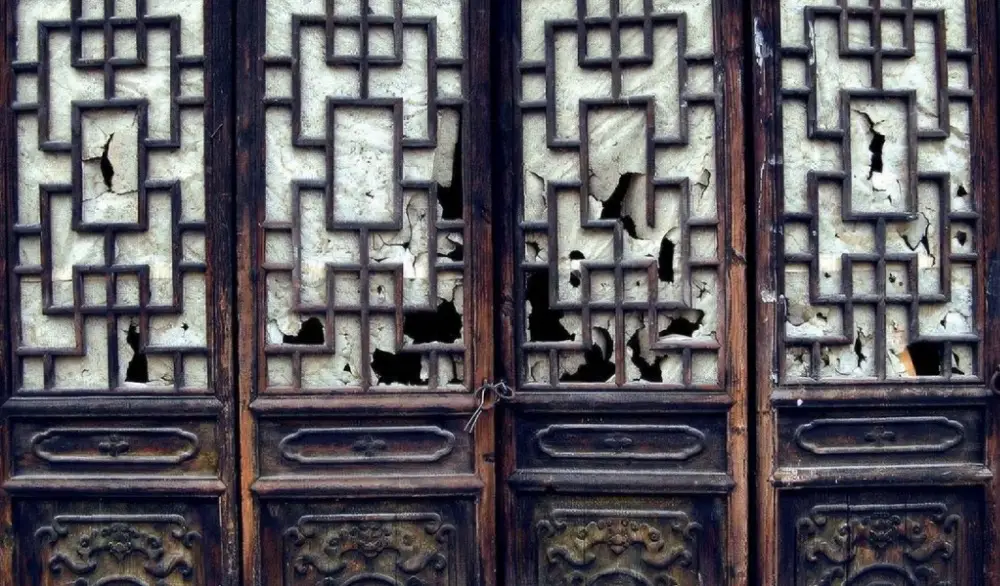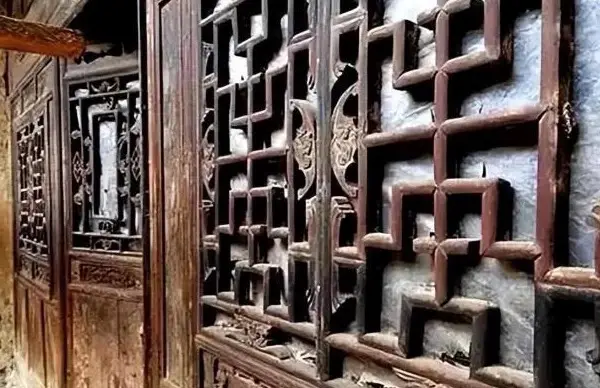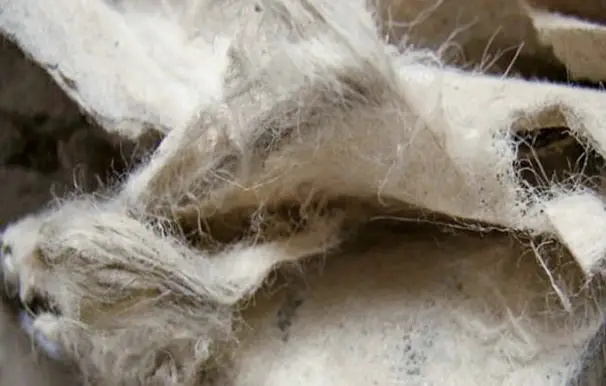Ancient Chinese windows were integral components of traditional architecture, carrying unique cultural significance and aesthetic value. They served not only as essential passages for ventilation and light but also as bridges for indoor-outdoor communication and spaces for emotional expression.
Ancient Chinese windows types
There existed diverse types of ancient Chinese windows, each with its distinct characteristics. Here are some commonly known types:
Straight Lattice Windows: These windows predominantly feature vertical lattice bars, simple in design resembling fences, facilitating the application of window paper. They were categorized into single-layered, non-opening windows, and double-layered windows that could be opened. During the Tang Dynasty, straight lattice windows reached their peak, considered a hallmark of architectural style.
Half Windows (Kan Chuang): Positioned halfway on walls, also known as half windows. They were often aligned with folding doors to enhance the exterior façade’s harmony and symmetry. During the Qing Dynasty, these were prevalent in imperial buildings and large residences.
Folding Casement Windows: Comprised of upper and lower sections, the upper part could be lifted, and the lower part could be removed. The inner layer was typically adorned with gauze or paper to ensure adequate indoor lighting. These windows were common in palaces and ordinary residences.
Horizontal Canopy Windows: Mainly utilized in the upper sections of lattice windows and half windows, relatively concealed and less efficient, hence less common in primary window areas of ancient architecture. Their primary function was for lighting purposes.
Pierced Windows (Lou Chuang): Constructed from carved stones, molded clay, blue bricks, tiles, or bamboo and wood. These windows feature various pierced patterns, allowing vague views of the outside, creating a misty and gentle aesthetic.
Assorted Patterned Windows (Shi Jin Chuang): Common decorative elements in traditional Chinese architecture, featuring patterns made of glass, ceramics, or other materials within the window grids. They served both functional and ornamental purposes.

Flower-Board Doors and Partitioned Windows: Flower-board doors comprise two symmetrically arranged semicircular shapes with a diamond-shaped hollow in the middle for decoration. Partitioned windows combined ventilation, lighting, and decorative functions while separating indoor spaces from the external environment. They typically consisted of four, six, or eight panels and were prevalent in ancient structures.
Lattice Casement Doors: Constructed with a horizontal frame between two wooden flat panels, forming a flexible and well-sealed window. Commonly used in small courtyard gardens as ventilation outlets or as interior partition walls.
ancient Chinese Windows history
Throughout the course of human civilization, windows, serving as the “eyes” of structures, hold undeniable significance. In China, the evolution of windows has traversed a long and diverse history.
During primitive societies, the concept of windows hadn’t yet formed. People simply used coverings at cave openings to protect interior spaces. As civilization advanced, awareness of the importance of light emerged, leading to the use of natural materials like leaves, animal skins, and grass mats to craft rudimentary windows. Despite their lightweight, easy availability, and replaceability, these materials didn’t provide ideal protection from wind and rain.
Entering the Qin and Han dynasties, advancements in textile technology introduced fabrics such as silk and cloth as primary window materials. These materials offered improved insulation, light control, and intricate designs, significantly enhancing the aesthetic appeal of windows. However, due to their relatively higher cost, they were mainly utilized in crucial buildings like palaces and temples.

During the Tang Dynasty, with the advent of printing, patterned paper was employed for windows. This paper was lightweight, cost-effective, and customizable with various designs and colors, elevating the decorative aspect of windows. Yet, its drawback lay in being fragile and less durable, primarily used in temporary structures or ordinary homes.
By the Song Dynasty, economic progress and advancements in construction techniques popularized wooden windows. These windows were sturdy, offered good insulation, and allowed intricate patterns and carvings, greatly enhancing their aesthetic appeal. Additionally, wooden windows were adorned through painting and varnishing, enhancing the overall appearance of buildings.
Beyond material evolution, the styles of ancient Chinese windows continually evolved. Initially simple openings in walls, the pursuit of beauty and improved living environments led to the development of various styles like lattice windows, grid windows, and floral windows. Among these, lattice windows were prevalent, employing wooden or bamboo strips in varied shapes within the window frames. These windows served both as wind barriers and decorations.
Beyond their practical functionality, ancient Chinese windows carried rich cultural connotations. Elements like window patterns and grids frequently appeared in literature, paintings, and architecture. People often associated windows with landscapes and sentiments, lending windows profound cultural meanings. For instance, poetic verses like “The window holds the thousand-year snow of the western ridges; the door parks a ship from Wu sailing ten thousand miles” and “When shall we together trim the candles by the western window and discuss the night rain in Bashan” express the close connection between windows and landscapes.
Why Chinese used paper windows
The usage of paper windows, also known as “zhi chuāng” in Chinese, was closely tied to the invention and widespread use of paper itself. Since Cai Lun’s refinement of papermaking during the Eastern Han Dynasty, paper gradually became an essential item for cultural exchange and daily life. Over time, people began using paper for window construction, replacing earlier materials like bamboo curtains and grass mats.
Paper windows boasted several advantages: they were lightweight, offered excellent translucency, effectively blocked wind and rain while allowing light to filter through for interior illumination. Additionally, the cost of producing paper windows was relatively low, leading to their widespread use in ancient China.
Beyond their practical utility, paper windows carried cultural significance. In ancient poetry, they often represented a sense of elegance and tranquility. Lines such as “The paper window brightens with the dawn; the cloth bed warms, heralding spring” portray this aesthetic ambiance. Moreover, paper windows served as a vital medium for traditional Chinese paper-cutting art, used to decorate interior spaces and express desires for a better life and blessings.

In ancient China, paper-pasted windows indeed demonstrated surprising resilience against weather conditions. The robustness of paper used for these windows was not as fragile as commonly assumed. In earlier times, the paper used was often tough and coarse due to less refined papermaking techniques. For instance, during the Northern Song Dynasty, paper made from rice straw or rattan was coarse, thick, and weighty, repurposed from written texts to be pasted onto windows. Later, techniques emerged to create tougher, thicker paper by soaking scraps of cloth, old paper, worn fibers, cotton, hemp bark, etc., to form robust hemp paper, ideal for pasting on windows.
Another type of paper frequently used for pasting windows was Goryeo paper, originating from Korea, introduced to China during the Tang and Song Dynasties. This paper, refined and glossy, allowed for calligraphy and painting. Its coarser variant, akin to leather in durability, was highly suitable for pasting windows. Although Goryeo paper was initially expensive, it became a primary material for window pasting during the Ming and Qing Dynasties. Even in the Forbidden City, most doors and windows were pasted with Goryeo paper, as documented in the “Qianlong Reign Code.” To enhance durability and waterproofing, craftsmen applied techniques such as coating the paper with tung oil, beeswax, or soybean oil. This not only preserved the paper but also reinforced its resistance to weather elements.
However, the delicate appearance of these paper windows in some TV dramas, susceptible to tearing with a slight touch, arises from two factors. First, some windows in these dramas represent “warm pavilion” interiors where weather protection isn’t a concern. They often feature expensive white paper for aesthetics, which, despite its delicacy, was chosen for its visual appeal. Second, aged windows, even if initially robust and protected with oil or wax, become fragile over time due to exposure to elements, making them vulnerable to damage even from minimal force.
Therefore, these paper windows were regularly replaced in ancient times, particularly during the lunar twelfth month when meticulous re-pasting occurred. The roofs of ancient houses usually had large eaves, preventing direct splashing of rainwater on windows, reducing the risk of water seeping through. Despite their historical usage, these paper windows didn’t offer significant privacy or security in ancient times.
Reference: Jinan News Network: “Why Were Ancient Windows Made of Paper and Could Withstand Wind and Rain?” 2023-12-06 14:44.